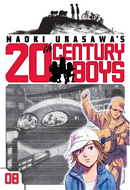   |
Manga-ka: Naoki Urasawa
Publisher: Viz Media
Rating: Teen (13+)
Release Date: May 2010
Synopsis: “This is the story of a group of boys who try to save the world! As boys, Kenji and his friends came up with a bunch of stories about an evil organization bent on world destruction. As adults, someone is now turning their fantasies into reality! What really happened on Bloody New Year’s Eve? Kenji, Otcho and Maruo have just driven their dynamite-loaded truck under the robot…where they see what a poor relation to the giant robot they dreamed up in their childhoods it actually is: just two legs with caterpillar treads, held together by an enormous hot air balloon, with cloth hanging down to disguise the underside.
Meanwhile, at the meeting of the government’s crisis control committee, Manjome Inshu unveils the Friend’s benevolent plan to distribute worldwide a vaccine against the virus being spread by the robot. The Friends, he says, have been developing such a vaccine since the terrorist germ attacks of 1997. At the same time, the Friends will contribute a monument they were building for their headquarters to serve as a blockade against the robot. The Friends are saving the day! Or are they?”
I’ve always liked stories where the main characters are fighting to take down a corrupt system (i.e. 1984, The Matrix). It automatically puts the cast in a proactive position and paints everything in a shade of grey. To us the main characters may be heroes, but from the other side it is very easy to label them as terrorists. This issue and many others are explored in 20th Century Boys volume 8, making this instalment not only full of tense thrills but also interesting philosophical dilemmas.
The volume starts off in the year 2000 with the giant robot attack on Tokyo. Kenji and co. race to blow up the machine before it kills even more people, but while doing so Kenji comes face to face with Friend, the evil mastermind behind it all.
The majority of this volume however is spent in 2014 with Koizumi Kyoko, a high school girl who’s been asking questions about the Bloody New Year’s Eve of 2000. Very quickly Kyoko realizes that she is in way over her head and tries to back out, but it’s too late. Government officials have taken notice of Kyoko’s interest and have chosen her (out of a supposedly random drawing) to attend a special camp called Friend Land. Before Kyoko can run away, she’s on a bus surrounded by scarily-cheerful Friend fanatics.
Once at the camp things get even weirder. Kyoko and the other teens spend their days playing video games where their opponents are Kenji and other ‘terrorists.’ Kyoko is the only who seems to notice that the games and activities are actually just brainwashing and tries to make a break for it. While making her escape she gets some help from an unexpected source, a ‘terrorist’ that supposedly died fourteen years ago.
The Flobots have a song that goes “There is a war going on for your mind. If you are thinking, you are winning.” Those lyrics perfectly sum up Kyoko’s struggle at the Friend Land. The games the kids played are designed to wear down their critical thinking skills to the point where they just accept everything the Friends tell them. Kyoko’s natural scepticism (and common sense) keep her sane. She might come across as an airhead, but beneath her valley girl exterior there is a person who is a very critical thinker with an urge to question everything. I really like characters who don’t fit the usual hero mould, and Urasawa excels at this (likewise, he’s also great at creating villains who are different from what you’d expect). In fact, one reason I like this volume is that it focus on Kyoko rather than the other teenage female character, Kanna. Kanna’s great: she’s smart and strong and plucky. She’s basically every Miyazaki heroine combined. But she’s a little too good: she has no flaws and everyone in the story acts as though her tears cure cancer. I prefer the people in my stories to have a few wrinkles too them, and Kanna is just too much of a shining light of virtue for me to really be interested in her as a character.
Speaking of characters, it is really great to see the cast from the 2000 plotline show up in the 2014 storyline. Seeing how the years have taken their toll is sobering, but at the same time it’s still reassuring to see that certain characters did indeed survive the Bloody New Year’s Eve. The character who makes a reappearance here is one of my favourite members from Kenji’s gang, largely because he makes such an unlikely hero (even he admits this). I won’t say who it is so as to not spoil the reveal, but eagle eyed readers will be able to figure it out early on.
The latter half of the book involves Kyoko and working with the resistance to find out Friend’s identity. There is a special level in the video game they play at the camp, and the resistance leader believes that the key to Friend’s identity lies in the game. To get to the special level Kyoko must first excel at all the other activities. This is harder than it sounds, since she must do so while still holding onto her sense of self, the very thing the games are designed to breakdown. Kyoko manages by singing a song over and over again in her head, a song by the glam rock band The Eloim Essaims. One of the repeated messages in the series is about the power of music and how it can be used as both a weapon and a shield. There’s a flashback early on in the book where we see Kenji play a song he wrote, and even without the benefit of sound the moment manages to be touching and inspiring.
Kyoko manages to get into the special bonus round. Instead of the usual shoot ‘em up games that she had been playing, Kyoko finds herself in 1971 in a little town. She stumbles upon a group of young boys who seem oddly familiar. It’s Kenji and the others. Kyoko goes with the group to a haunted house, where she overhears a strange conversation between two children. Could one of them be friend?
This volume of 20th Century Boys manages to move the plot forward a far bit while not sacrificing things like character moments and world building. The volume is full of tense sequences, including a payoff to a moment set up within the first pages of volume one. It’s getting harder and harder to guess what will happen next as the story moves forward, and that just makes it more exciting.
The art is consistently amazing. The backgrounds are detailed and recognizable (you almost don’t need the date cards, since it’s usually clear from the art what year it is). Urasawa has set himself up with a really hard task concerning the main cast: he has to draw them at various ages depending on the story. He pulls it off perfectly. He’s also a master of facial expressions. For most of the cast the expressions are extremely subtle: Kyoko’s councillor at Friend Land can turn a welcoming smile into something completely sinister with just a raise of her eyebrow. As for Kyoko, I like her design in that she’s probably the most expressive character in the series. Seeing her extreme reactions to the craziness around offers some comedic relief in what can be a dark manga.
Viz does a pretty good job with the translation here. The footnotes at the back explain some of the Japanese pop-culture references. In at least one case I think that maybe the reference was too obscure and that the joke would have worked better if it was changed, but that’s a minor complaint. I don’t like Viz’s policy of redoing the artwork for the sound effects, but since Urasawa doesn’t use sound effects too often it’s not so big of an issue here.
20th Century Boys always manages to end on a cliffhanger and this volume is no exception. The wait between volumes is painful, but at least there is a lot to think about and puzzle over before the next instalment.
Review written June 15, 2010 by Shannon Fay
Book purchased from Strange Adventures


 Follow
Follow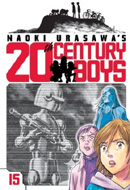

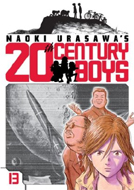





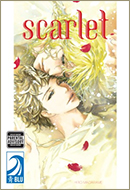








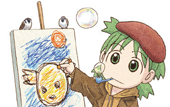









[…] Fay on vol. 8 of 20th Century Boys (Kuriousity) Deb Aoki on vol. 1 of Afterschool Charisma (About.com) Leroy Douresseaux on vol. 1 of […]
20th Century Boys has become one of my favorite manga. Even volume is thrilling which is not surprising coming from Naoki Urasawa. He's a true gem in my eyes.
After reading Monster, I became an instant Urasawa fan. I also read Pluto which is absolutely a magnificent read. I highly recommend manga readers to read 20th Century Boys as well as Monster and Pluto.
Manga fans should definitely be reading Urasawa, but what I find interesting about him is that he's one of the few manga-ka to have genuine cross-over appeal to American comic book readers. I've meet a lot of people who don't really like manga but love Urasawa.
@Shannon – I'm a "double dipper" because I like to read both manga and American comics. His cross-over appeal to American comic book readers is indeed interesting. Also, I truly like how Viz is handling his work.